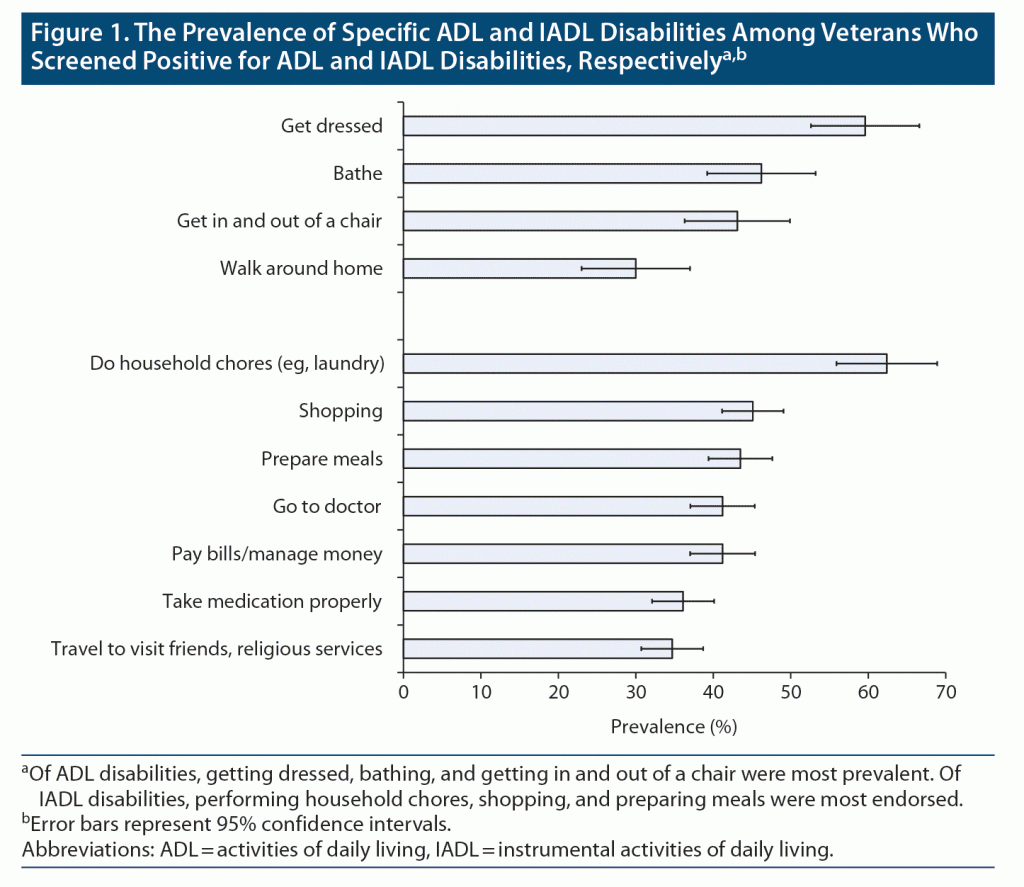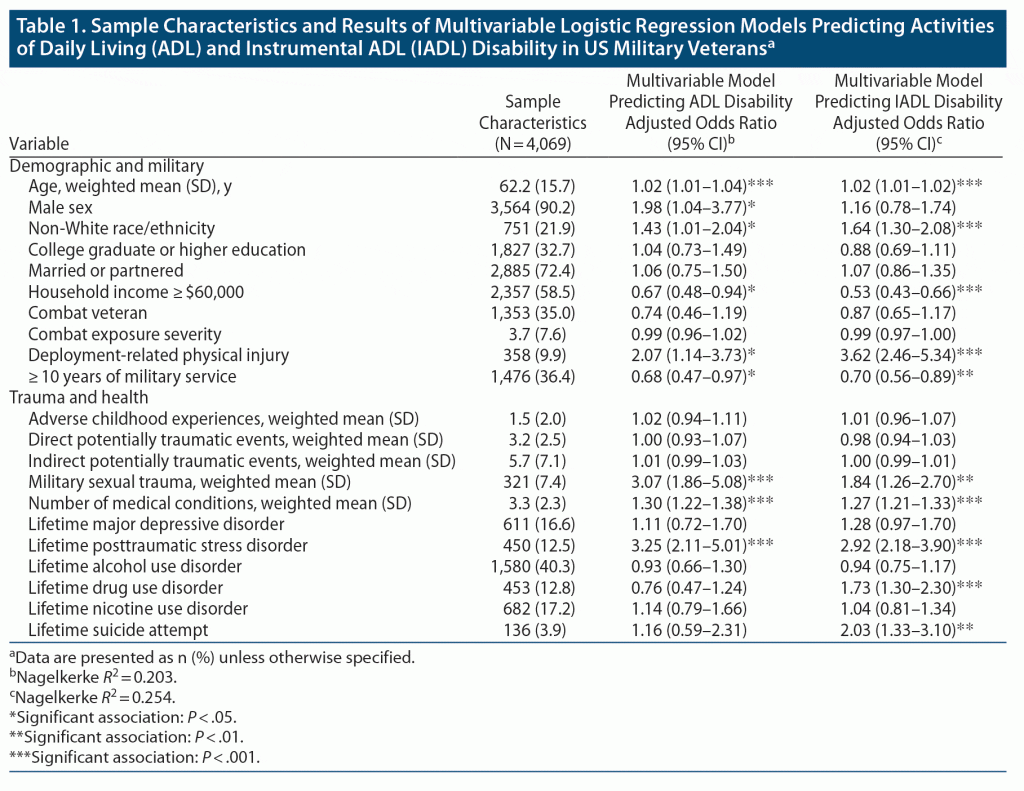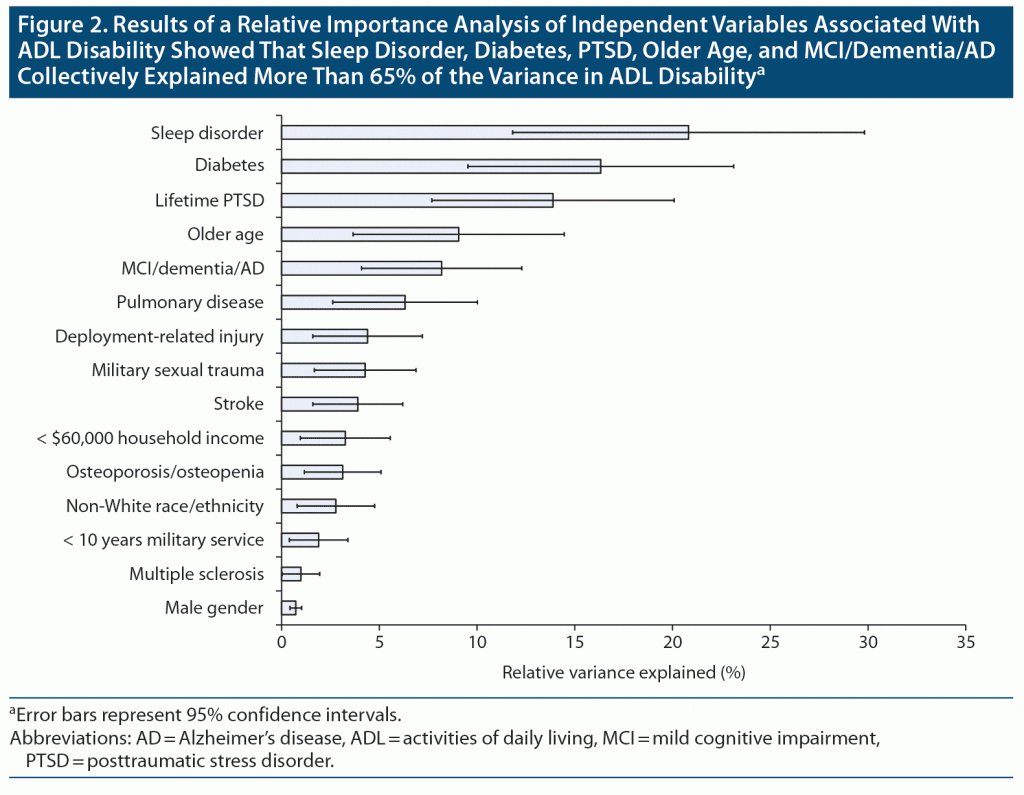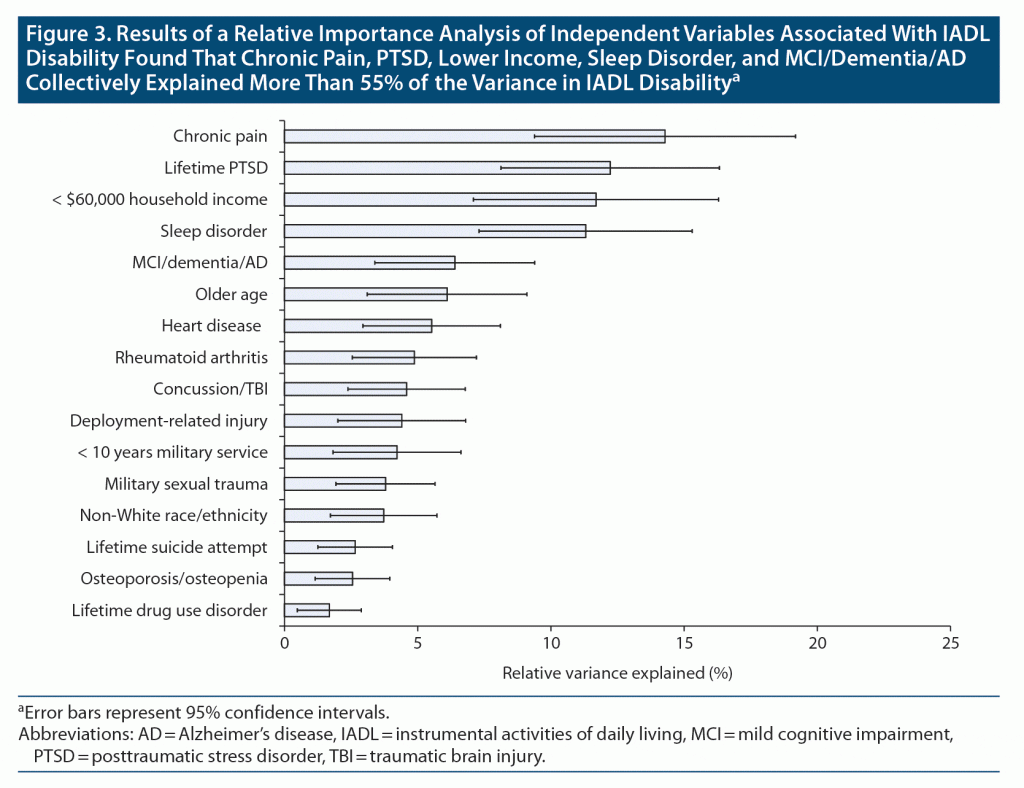ABSTRACT
Objective: To examine the prevalence and sociodemographic, medical, and psychiatric correlates of disability in activities of daily living (ADLs) and instrumental ADLs (IADLs) in the US veteran population.
Methods: Data were analyzed from 4,069 US veterans who participated in the 2019–2020 National Health and Resilience in Veterans Study (NHRVS). Multivariable and relative importance analyses (RIAs) were conducted to identify independent and strongest correlates of ADL and IADL disability.
Results: A total of 5.2% (95% CI, 4.4%–6.2%) and 14.2% (95% CI, 12.8%–15.7%) of veterans reported ADL and IADL disability, respectively. Older age, male sex, Black race, lower income, and deployment-related injuries were associated with ADL and IADL disabilities, as were certain medical and cognitive conditions. Results of RIAs revealed that sleep disorders, diabetes, posttraumatic stress disorder (PTSD), older age, and cognitive disorders were most strongly associated with ADL disability, while chronic pain, PTSD, lower income, and sleep and cognitive disorders were most strongly associated with IADL disability.
Conclusions: Results of this study provide an up-to-date estimate of the prevalence and sociodemographic, military, and health correlates of functional disability in US veterans. Improved identification and integrated clinical management of these risk factors may help mitigate disability risk and promote the maintenance of functional capacity in this population.
Prim Care Companion CNS Disord. 2023;25(4):22m03461
Author affiliations are listed at the end of this article.
Functional disabilities include difficulties in basic activities of daily living (ADLs; eg, hygiene, eating, ambulating) as well as in instrumental ADLs (IADLs; eg, grocery shopping, housekeeping, meal preparation, and managing finances).1,2 Many factors, including sociodemographic characteristics, health conditions (eg, cardiac disease, chronic pain, cognitive decline/dementia), and lack of social supports, are associated with increased functional disability in older individuals.3–5 The clinical and public health consequences of these disabilities are significant, with functional disability being linked to poorer quality of life, increased mortality risk, and greater use of health care services.6–8
Although aging and poor health have been identified as the primary correlates of functional disability, the comorbidity of psychiatric and physical health conditions has gained increasing attention. For example, Connolly et al,3 in a community-based study of 3,499 respondents aged ≥ 65 years in Ireland, found that depression, pain, and cognitive difficulties were significant correlates of disability. In a study of 4,017 Medicare beneficiaries, Quiñones et al9 reported that depression and/or cognitive impairment were present in one-third of older adults with chronic physical health conditions and that this combination was associated with 34% increased risk of developing ADL and IADL disability relative to multimorbidity combinations of exclusively physical health conditions. Similarly, in a study of 25,000 older individuals across Europe, Sheridan et al10 found that the combination of depressive symptoms and somatic conditions was most strongly linked to ADL/IADL disability risk relative to multimorbidity combinations that did not include depressive symptoms. Collectively, these results underscore the importance of whole health approaches11 that consider physical, mental, and cognitive health conditions when examining risk factors for ADL/IADL disability.
Functional limitations due to ADL and IADL impairments may be particularly prevalent among US military veterans. Veterans are, on average, 20 years older than nonveterans (median age of 64 vs 44 years12) and have been found to have high rates of physical health problems.13,14 Studies have also shown that older veterans are more prone to certain medical conditions, including heart disease15 and some forms of cancer.16 Veterans also have higher rates of mental disorders such as posttraumatic stress disorder (PTSD) relative to nonveterans,17 and PTSD has consistently been linked to poorer health and increased utilization of medical services among military veterans.18–20 A recent study by Moye and colleagues,21 which analyzed data from a large population-based study of older US veterans, found that both PTSD and subthreshold PTSD were prevalent—1.9% and 9.6%, respectively—and associated with decrements in physical, mental, and cognitive functioning.
Despite evidence indicating a high burden of physical and mental health conditions in veterans, no known study has examined the prevalence and specific physical and mental health correlates of ADL and IADL disability in a population-based sample of US military veterans. This information is critical to characterizing the burden of functional disability in US veterans, as well as potential targets for prevention and treatment efforts designed to mitigate risk for disability, and to maintain functional capacity in this population. To address this gap, we analyzed data from a large contemporary and nationally representative sample of US military veterans to (1) examine the prevalence of ADL and IADL disability, (2) identify sociodemographic and military characteristics and physical and mental health conditions associated with ADL and IADL disabilities, and (3) quantify the relative contributions of specific correlates of disability while accounting for intercorrelations of these factors.
METHODS
Sample
The National Health and Resilience in Veterans Study (NHRVS) is a nationally representative survey of 4,069 US veterans that was conducted between November 18, 2019, and March 8, 2020. Veterans completed a 50-minute, anonymous, web-based survey. The NHRVS sample was drawn from KnowledgePanel, a research panel of more than 50,000 households maintained by Ipsos, a survey research firm. KnowledgePanel is a probability-based, online, nonvolunteer access survey panel of a nationally representative sample of US adults that covers approximately 98% of US households. Panel members are recruited through national random samples, originally by telephone and now almost entirely by postal mail. KnowledgePanel recruitment uses dual sampling frames that include both listed and unlisted telephone numbers, telephone and non-telephone households, and cell phone–only households, as well as households with and without internet access.
To permit generalizability of study results to the entire population of US veterans, the Ipsos statistical team computed poststratification weights using the following benchmark distributions of US military veterans from the most recent (August 2019) Current Veteran Population Supplemental Survey of the US Census Bureau’s American Community Survey22: age, gender, race/ethnicity, Census region, metropolitan status, education, household income, branch of service, and years in service. An iterative proportional fitting (raking) procedure was used to produce the final poststratification weights. All participants provided informed consent, and the study protocol was approved by the Human Subjects Subcommittee of the VA Connecticut Healthcare System.
Assessments
ADL disability. Disability in ADLs was assessed using 4 questions derived from the Lawton Instrumental Activities of Daily Living Scale,1,2 with questions inquiring if an individual requires assistance from another person for (1) bathing, (2) dressing, (3) getting in and out of a chair, and (4) ambulating (Cronbach α = .76). Endorsement of 1 or more of these items was indicative of the presence of ADL disability.
IADL disability. Disability in IADLs was also adapted from the Lawton scale,1,2 with questions inquiring if an individual requires assistance from another person for (1) shopping, (2) going to health care appointments, (3) traveling locally, (4) paying bills or money management, (5) meal preparation, (6) household chores, and (7) taking medication (Cronbach α = .88). Endorsement of 1 or more of these items was indicative of the presence of IADL disability.
Independent variables. Supplementary Table 1 describes all sociodemographic, military, trauma-related, and health variables that were examined as correlates of ADL and IADL disability.
Data Analysis
Data analyses proceeded in 4 steps. First, descriptive statistics were computed to summarize sample characteristics for the full sample and the prevalence of specific ADL and IADL disabilities among veterans who reported at least 1 of these disabilities. Second, 2 multivariable binary logistic regression models were conducted to identify sociodemographic, military, trauma, and physical and mental health variables that were independently associated with ADL and IADL disability. Variables unique to veterans, including length of time served in the military and any service-related injuries, were included in the model to determine whether they may be linked to disability in this population. Third, when summary variables (eg, number of medical conditions) emerged as significant correlates of ADL and/or IADL disability, we conducted post hoc regression analyses to identify specific components of these variables that were independently associated with ADL and/or IADL disability. Given that independent factors associated with disability are often correlated,5 we then conducted relative importance analyses (RIAs), which model intercorrelations among independent correlates, to identify the strongest correlates of ADL and IADL disability. RIAs were conducted using the R package relaimpo, which partitions explained variance among multiple predictors to better understand the variance in a dependent variable that is explained by each independent variable in a regression equation.23,24 To permit generalizability of study results to the entire population of US veterans, poststratification weights were applied in inferential analyses. Statistical significance was evaluated at the .05 level.
RESULTS
Prevalence of ADL and IADL Disability
A total of 212 veterans (weighted 5.2%, 95% CI, 4.4%–6.2%) endorsed at least 1 ADL disability, and 549 veterans (weighted 14.2%, 95% CI, 12.8%–15.7%) endorsed at least 1 IADL disability. On average, veterans with an ADL disability endorsed 1.8 (SD = 1.0; range, 1–4) specific ADL disabilities, and veterans with an IADL disability endorsed 3.0 (SD = 1.9; range, 1–7) specific IADL disabilities.
Figure 1 shows the prevalence of specific ADL and IADL disabilities among veterans who reported at least 1 disability. Disability in getting dressed, bathing, and getting in and out of a chair were the most prevalent ADL disabilities, while performing household chores, shopping, and preparing meals were the most prevalent IADL disabilities.
Sample Characteristics and Multivariable Analyses
Table 1 shows sample characteristics and results of regression models predicting ADL and IADL disability. Results revealed that older age, non-White race/ethnicity, lower household income, deployment-related physical injury, fewer years of military service, military sexual trauma, greater number of medical conditions, and lifetime PTSD were independently associated with both ADL and IADL disability. Male sex was additionally associated with ADL disability, while lifetime drug use disorder and suicide attempt were additionally associated with IADL disability.
Post Hoc Analyses: ADL Disability
Post hoc regression analyses including demographic and relevant medical and psychiatric variables revealed that Black, non-Hispanic veterans had higher odds of ADL disability relative to White, non-Hispanic veterans (OR = 1.78, 95% CI, 1.14–2.79). Medical conditions associated with ADL disability included mild cognitive impairment (MCI)/dementia/Alzheimer’s disease (AD; OR = 5.57, 95% CI, 3.04–10.22), multiple sclerosis (OR = 4.68, 95% CI, 1.12–19.60), sleep disorder (OR = 2.61, 95% CI, 1.87–3.64), osteoporosis/osteopenia (OR = 2.26, 95% CI, 136–3.77), stroke (OR = 1.85, 95% CI, 1.01–3.40), pulmonary disorder (OR = 1.81, 95% CI, 1.23–2.65), and diabetes (OR = 1.57, 95% CI, 1.11–2.21). Each of these conditions was independently associated with ADL disability.
As shown in Figure 2, results of an RIA indicated that, after accounting for the shared variance among these independent variables, lifetime PTSD and sleep disorders emerged as 2 of the top 3 predictors of ADL disability, explaining 37% of the total variance. When combined with diabetes, age, and MCI/dementia/AD, these variables explained more than 70% of the variance in ADL disability. Although accounting for smaller percentages of the variance in ADL disability, military-specific factors including length of time served, deployment-related injury, and history of military sexual trauma also emerged as significant predictors.
Post Hoc Analysis: IADL Disability
Post hoc regression analyses revealed that Black, non-Hispanic (OR = 1.82, 95% CI, 1.36–2.44), and Hispanic (OR = 1.74, 95% CI, 1.18–2.56) veterans had higher odds of IADL disability relative to White, non-Hispanic veterans and that medical conditions associated with IADL disability included MCI/dementia/AD (OR = 3.90, 95% CI, 2.23–6.80), osteoporosis/osteopenia (OR = 2.24, 95% CI, 1.48–3.38), rheumatoid arthritis (OR = 2.01, 95% CI, 1.41–2.87), chronic pain (OR = 1.78, 95% CI, 1.42–2.24), sleep disorder (OR = 1.64, 95% CI, 1.31–2.06), concussion/traumatic brain injury (OR = 1.67, 95% CI, 1.15–2.41), and heart disease (OR = 1.56, 95% CI, 1.20–2.05).
As shown in Figure 3, results of an RIA indicated that, after accounting for the shared variance among independent variables, lifetime PTSD and sleep disorders emerged as 2 of the top 4 predictors of IADL disability, explaining 25% of the total variance. When combined with chronic pain, income, and MCI/dementia/AD, these variables explained more than 55% of the variance in IADL disability. Although accounting for smaller percentages of the variance in IADL disability, 3 military-specific factors, including length of time served, deployment-related injury, and history of military sexual trauma, as well as history of concussion/traumatic brain injury, drug use disorder, and suicide attempt also emerged as significant predictors.
DISCUSSION
Results of this population-based study of US military veterans revealed that both ADL and IADL disability were prevalent, affecting 1 of 20 and 1 of 7 veterans, respectively. They further identified sociodemographic, medical, and psychiatric factors associated with disability. As has been observed in prior population-based studies (eg, Connolly et al3), age, male sex, lower socioeconomic status, and physical injuries were strongly associated with both ADL and IADL disability. Race/ethnicity was also a significant factor, with Black veterans having 78% greater odds of ADL disability than White veterans and 82% greater odds of IADL disability; Hispanic veterans also had 74% greater odds of IADL disability. These findings parallel epidemiologic and sociologic studies in nonveteran population–based samples (eg, Fuller-Thomson et al25) and suggest that specific segments of the veteran population may be at increased risk of disability. They particularly underscore the burden of functional disability in Black and Hispanic veterans.
Consistent with prior work,26,27 certain medical conditions were equally predictive of both ADL and IADL disabilities, particularly those involving cognitive impairments (eg, MCI/AD/dementia). Sleep disorders were also identified as key correlates of ADL and IADL disabilities, which aligns with prior work showing a high prevalence of sleep impairments in older populations,28 especially among those with comorbid medical conditions.29 Sleep deprivation and disorders are also known to adversely impact cognitive functioning.30,31
In the current sample, although advancing age was strongly associated with disability, even younger veterans reported elevated levels of ADL and IADL impairments, which are rarely, if ever, found in community-based studies involving younger individuals (eg, Adams et al32). To better understand the role of age in disability in the current sample, a post hoc analysis of the prevalence of ADL and IADL disability by age groups was conducted. Surprisingly, the prevalence of ADL disability was similar across age groups, with 3.1%, 3.6%, 5.7%, and 5.5% of veterans aged 18–29, 30–44, 45–59, and ≥ 60 years endorsing such a disability (χ21 = 4.97, P = .17), respectively. Further, the prevalence of IADL disability was highest among veterans aged 30–44, with 18.0% reporting at least 1 IADL disability relative to 4.6% of veterans aged 18–29, 12.5% in those aged 45–59, and 14.2% in those aged ≥ 60 (χ21 = 14.96, P = .002). It is likely that the finding reflects the disproportionately higher rates of mental and certain physical health difficulties (eg, chronic pain) in veterans who served in the Iraq and Afghanistan conflict, the majority of whom are now in the age bracket 30–44 years. The finding of such a high prevalence of IADL disability in this age cohort of veterans underscores the need for increased attention to the management of risk factors for IADL disability in this group, which may be overlooked in studies of functional disability.
With respect to psychiatric variables, a lifetime diagnosis of PTSD was a significant independent predictor of both ADL and IADL disability. For IADL disability, PTSD was the second strongest predictor after chronic pain, and for ADL disability, it was the third strongest predictor after sleep disorders and diabetes. Previous studies18–20 have similarly highlighted the profound impact that PTSD can have on functional abilities.
Previous studies have also found that mood disorders (eg, major depression) were predictive of impairments in ADL and IADL (eg, Katon et al33). Although this finding was not replicated in the current study, lifetime suicide attempt was associated with IADL disability, suggesting that, at least in this sample, lifetime suicide attempt may be a proxy for severe lifetime mood disorders and their negative impact on IADLs. A lifetime history of substance use disorders (SUDs) was also associated with IADL disability. These findings are likely interrelated, as the presence of SUDs is a strong risk factor for suicide.34 Additionally, there is some indication that individuals with a history of SUDs are more likely to experience cognitive impairments due to their substance use, with previous research showing that between 30% and 80% of patients with SUDs experience cognitive difficulties.35 Given that IADLs encompass more complex and cognitively demanding tasks, even mild cognitive difficulties may be linked to IADL disability.
Unique to the veteran population, results of this study revealed that longevity in the military, operationalized as having served 10+ years in service, seemed to protect veterans from experiencing both ADL and IADL disability. This may reflect greater resilience, both psychological and physical, for veterans who chose—and were able—to serve longer military careers. It is also possible that earlier onset of functional disability, or the medical and psychiatric conditions predisposing to the later onset of disability, may lead to fewer years in military service. Future study of active-duty service members who are followed prospectively into older adulthood is needed to elucidate mechanistic pathways to health and disability.
Collectively, results of this study have several implications for clinical practice. First, given the impact that sleep difficulties, PTSD, and MCI/dementia have on functional abilities—including both basic self-care tasks and more complex tasks required for independent living—increased prevention and intervention efforts (including more frequent screening and monitoring) should be directed toward veterans at greater risk for developing these conditions. Given the large and aging population of US veterans with a high prevalence of these risk factors, efforts to treat these conditions to prevent—or at least delay—the onset of functional disability may have significant benefits clinically and to public health more broadly. As noted above, given high rates of disability among younger veterans, the findings also support increased screening and intervention for these psychiatric and cognitive risk factors in early-to-mid adulthood. Second, the finding that 1 of 7 US veterans reported an IADL disability highlights the importance of routinely assessing not only risk factors but also actual disability status in clinical settings and promoting clinical and policy efforts to provide necessary supports. Third, given that a broad range of physical, mental, and cognitive risk factors were linked to ADL and IADL disability, integrated assessment, monitoring, prevention, and treatment approaches that consider this constellation of risk factors for ADL and IADL disability may be particularly helpful in managing disability risk and burden. The Veterans Health Administration (VHA) has been at the forefront of promoting whole health initiatives focused on health promotion and disease prevention,11 as well as integrated mental and physical health assessments and interventions in primary care settings.36 However, given that only 20% of veterans utilize the VHA as their primary source of health care37 and that VHA facilities are more likely than non-VHA facilities to provide integrated primary care services,38 the current findings underscore the importance of expanding such efforts in the broader community.
Limitations of this study must be noted. First, the data were derived from a cross-sectional sample of veterans and thus are correlational and cannot be used to infer causal relationships. Second, all information regarding disability status and medical and psychiatric history was ascertained using self-report measures; therefore, the conditions reported may not have been diagnosed by health care providers and thus may either underrepresent or overrepresent prevalence of actual diagnoses. Third, although nationally representative, the NHRVS cohort consisted mostly of older White men; therefore, it is possible that these findings may not generalize to more sociodemographically diverse subsets of the veteran population.
Notwithstanding these limitations, results of this study provide the first known population-based data on the prevalence and correlates of ADL and IADL disability in US military veterans. Findings highlight the importance of certain health conditions—most notably sleep disorders, chronic pain, PTSD, and MCI/dementia—as key correlates of ADL and IADL disability in this population. They also suggest a high burden of IADL disability among racial/ethnic minority veterans, as well as those aged 30–44 years, which underscores the importance of prevention and early intervention efforts to help mitigate risk for functional disability in these segments of the veteran population. Further research is needed to examine the replicability of these findings in more sociodemographically diverse samples of veterans; assess longitudinal associations between physical, mental, and cognitive risk factors and ADL and IADL disability; and evaluate the effectiveness of identification and prevention strategies targeting key disability risk factors to reduce the prevalence and impact of functional disability in this population.
Article Information
Published Online: July 4, 2023. https://doi.org/10.4088/PCC.22m03461
© 2023 Physicians Postgraduate Press, Inc.
To Cite: Meisler AW, Gianoli MO, Na PJ, et al. Functional disability in US military veterans: the importance of integrated whole health initiatives. Prim Care Companion CNS Disord. 2023;25(4):22m03461
Author Affiliations: VA Connecticut Healthcare System, West Haven (Meisler, Gianoli, Na, Pietrzak); Department of Psychiatry, University of Connecticut School of Medicine, Farmington (Meisler, Gianoli); Department of Psychiatry, Yale School of Medicine, New Haven (Meisler, Gianoli, Na, Pietrzak); Department of Social and Behavioral Sciences, Yale School of Public Health, New Haven, Connecticut (Pietrzak); National Center for PTSD, VA Connecticut Healthcare System, West Haven (Pietrzak).
Corresponding Author: Robert H. Pietrzak, PhD, MPH, US Department of Veterans Affairs National Center for Posttraumatic Stress Disorder, 950 Campbell Ave 151E, West Haven, CT ([email protected]).
Relevant Financial Relationships: None.
Funding/Support: None.
Supplementary Material: See accompanying pages.
Clinical Points
- Older age, male sex, Black race, lower income, and deployment-related injuries were associated with activities of daily living (ADL) and instrumental ADL (IADL) disabilities, as were certain medical and cognitive conditions.
- The high burden of IADL disability among racial/ethnic minority veterans, as well as those aged 30–44 years, underscores the importance of prevention and early intervention efforts to help mitigate risk for functional disability in these segments of the veteran population.
- Improved identification and integrated clinical management of sociodemographic, military, and health risk factors may help mitigate disability risk and promote the maintenance of functional capacity in US veterans.
References (38)

- Hardy SE, Gill TM. Recovery from disability among community-dwelling older persons. JAMA. 2004;291(13):1596–1602. PubMed CrossRef
- Graf C. The Lawton Instrumental Activities of Daily Living Scale. Am J Nurs. 2008;108(4):52–62, quiz 62–63. PubMed CrossRef
- Connolly D, Garvey J, McKee G. Factors associated with ADL/IADL disability in community dwelling older adults in the Irish longitudinal study on ageing (TILDA). Disabil Rehabil. 2017;39(8):809–816. PubMed CrossRef
- Ćwirlej-Sozańska A, Wiśniowska-Szurlej A, Wilmowska-Pietruszyńska A, et al. Determinants of ADL and IADL disability in older adults in southeastern Poland. BMC Geriatr. 2019;19(1):297. PubMed CrossRef
- Millán-Calenti JC, Tubío J, Pita-Fernández S, et al. Prevalence of functional disability in activities of daily living (ADL), instrumental activities of daily living (IADL) and associated factors, as predictors of morbidity and mortality. Arch Gerontol Geriatr. 2010;50(3):306–310. PubMed CrossRef
- Freedman VA, Martin LG, Schoeni RF. Recent trends in disability and functioning among older adults in the United States: a systematic review. JAMA. 2002;288(24):3137–3146. PubMed CrossRef
- Jonkman NH, Del Panta V, Hoekstra T, et al. Predicting trajectories of functional decline in 60- to 70-year-old people. Gerontology. 2018;64(3):212–221. PubMed CrossRef
- Raina P, Gilsing A, Mayhew AJ, et al. Individual and population level impact of chronic conditions on functional disability in older adults. PLoS One. 2020;15(2):e0229160. PubMed CrossRef
- Quiñones AR, Markwardt S, Thielke S, et al. Prospective disability in different combinations of somatic and mental multimorbidity. J Gerontol A Biol Sci Med Sci. 2018;73(2):204–210. PubMed CrossRef
- Sheridan PE, Mair CA, Quiñones AR. Associations between prevalent multimorbidity combinations and prospective disability and self-rated health among older adults in Europe. BMC Geriatr. 2019;19(1):198. PubMed CrossRef
- Marchand WR, Beckstrom J, Nazarenko E, et al. The Veterans Health Administration whole health model of care: early implementation and utilization at a large healthcare system. Mil Med. 2020;185(11-12):e2150–e2157. PubMed CrossRef
- United States Department of Veterans Affairs. Profile of Veterans: 2017. National Center for Veterans Analysis and Statistics, March 2019. US Department of Veterans Affairs website. Accessed May 15, 2023. https://www.va.gov/vetdata/docs/SpecialReports/Profile_of_Veterans_2017.pdf
- Betancourt JA, Granados PS, Pacheco GJ, et al. Exploring health outcomes for US veterans compared to non-veterans from 2003 to 2019. Healthcare (Basel). 2021;9(5):604. PubMed
- Hoerster KD, Lehavot K, Simpson T, et al. Health and health behavior differences: US military, veteran, and civilian men. Am J Prev Med. 2012;43(5):483–489. PubMed CrossRef
- Assari S. Veterans and risk of heart disease in the United States: a cohort with 20 years of follow up. Int J Prev Med. 2014;5(6):703–709. PubMed
- Chamie K, DeVere White RW, Lee D, et al. Agent orange exposure, Vietnam war veterans, and the risk of prostate cancer. Cancer. 2008;113(9):2464–2470. PubMed CrossRef
- Lehavot K, Katon JG, Chen JA, et al. Post-traumatic stress disorder by gender and veteran status. Am J Prev Med. 2018;54(1):e1–e9. PubMed CrossRef
- Pacella ML, Hruska B, Delahanty DL. The physical health consequences of PTSD and PTSD symptoms: a meta-analytic review. J Anxiety Disord. 2013;27(1):33–46. PubMed CrossRef
- Nichter B, Norman S, Haller M, et al. Physical health burden of PTSD, depression, and their comorbidity in the US veteran population: morbidity, functioning, and disability. J Psychosom Res. 2019;124:109744. PubMed CrossRef
- Schnurr PP, Jankowski MK. Physical health and post-traumatic stress disorder: review and synthesis. Semin Clin Neuropsychiatry. 1999;4(4):295–304. PubMed
- Moye J, Kaiser AP, Cook J, et al. Post-traumatic stress disorder in older US military veterans: prevalence, characteristics, and psychiatric and functional burden. Am J Geriatr Psychiatry. 2022;30(5):606–618. PubMed CrossRef
- US Census Bureau Current Population Survey, August 2019 Veterans Supplement. Census.gov website. Accessed May 15, 2023. https://www2.census.gov/programs-surveys/cps/techdocs/cpsaug19.pdf
- Tonidandel S, LeBreton JM. Determining the relative importance of predictors in logistic regression: an extension of relative weight analysis. Organ Res Methods. 2010;13(4):767–781. CrossRef
- Groemping U. Relative importance for linear regression in R: the package relaimpo. J Stat Softw. 2007;17(1):1–27.
- Fuller-Thomson E, Nuru-Jeter A, Minkler M, et al. Black-White disparities in disability among older Americans: further untangling the role of race and socioeconomic status. J Aging Health. 2009;21(5):677–698. PubMed CrossRef
- Brown PJ, Devanand DP, Liu X, et al; Alzheimer’s Disease Neuroimaging Initiative. Functional impairment in elderly patients with mild cognitive impairment and mild Alzheimer disease in MCI and AD patients. Arch Gen Psychiatry. 2011;68(6):617–626. PubMed CrossRef
- Lindbergh CA, Dishman RK, Miller LS. Functional disability in mild cognitive impairment: a systematic review and meta-analysis. Neuropsychol Rev. 2016;26(2):129–159. PubMed CrossRef
- Foley DJ, Monjan AA, Brown SL, et al. Sleep complaints among elderly persons: an epidemiologic study of three communities. Sleep. 1995;18(6):425–432. PubMed CrossRef
- Katz DA, McHorney CA. Clinical correlates of insomnia in patients with chronic illness. Arch Intern Med. 1998;158(10):1099–1107. PubMed CrossRef
- Pilcher JJ, Huffcutt AI. Effects of sleep deprivation on performance: a meta-analysis. Sleep. 1996;19(4):318–326. PubMed CrossRef
- Vardanian M, Ravdin L. Cognitive complaints and comorbidities in obstructive sleep apnea. Sleep Med Clin. 2022;17(4):647–656. PubMed CrossRef
- Adams PF, Kirzinger WK, Martinez ME. Summary health statistics for the US population: national health interview survey, 2011. Vital Health Stat 10. 2012;(255):1–110. PubMed
- Katon W, Sullivan M, Russo J, et al. Depressive symptoms and measures of disability: a prospective study. J Affect Disord. 1993;27(4):245–254. PubMed CrossRef
- Hill ML, Nichter B, Loflin M, et al. Comparative associations of problematic alcohol and cannabis use with suicidal behavior in US military veterans: a population-based study. J Psychiatr Res. 2021;135:135–142. PubMed CrossRef
- Copersino ML, Fals-Stewart W, Fitzmaurice G, et al. Rapid cognitive screening of patients with substance use disorders. Exp Clin Psychopharmacol. 2009;17(5):337–344. PubMed CrossRef
- Mastroleo NR, Possemato K, King PR, et al. Development and initial testing of a brief, integrated intervention aimed at reducing heavy alcohol use and PTSD among military veterans in primary care. Prof Psychol Res Pr. 2023;54(1):70–82. CrossRef
- Meffert BN, Morabito DM, Sawicki DA, et al. US veterans who do and do not utilize Veterans Affairs health care services: demographic, military, medical, and psychosocial characteristics. Prim Care Companion CNS Disord. 2019;21(1):18m02350. PubMed CrossRef
- Loho H, Rosenheck RA. Provision of mental health services in the Veterans Health Administration: a nationwide comparison with other providers. Psychiatr Serv. 2023;74(5)472–479. PubMed
Please sign in or purchase this PDF for $40.








